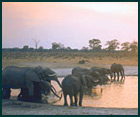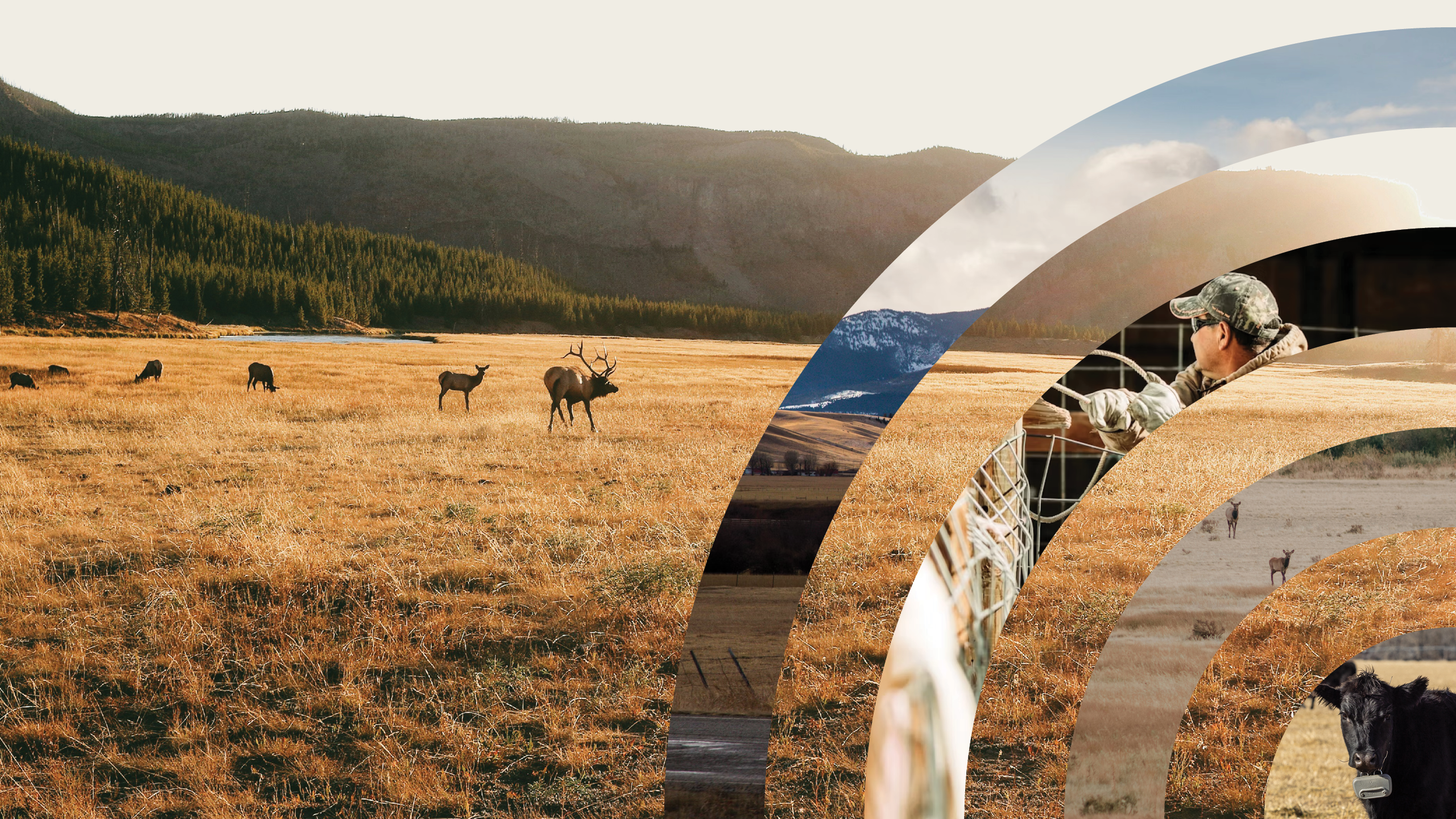
Although he set in place the legislation to do so, my father failed to achieve the same on communal lands only because of the racial politics of the time. He passed this baton on to me.
At the time, the landscape was dominated — and often degraded — by cattle, which were supported by massive subsidies. My father and I both believed that Africa’s indigenous fauna had ecological and economical benefits over cattle monocultures, but wildlife was hugely undervalued. Landholders were still not permitted to use wildlife commercially, so they gave free hunting to friends, while the state provided cheap hunting almost as a social service. Without value to landholders, wildlife disappeared.
After landholders became effective owners of wildlife on their property, the true value of wildlife began to emerge.
LEVELING THE PLAYING FIELD
In the early 1980s, the wildlife department set about leveling the playing field between wildlife and livestock ranching. Against much opposition from the powerful hunting lobby, Child senior began to raise the government-set hunting prices. Soon, bids and auctions completely replaced administrative pricing and allocation by lottery, and the constant lobbying of government officials by hunters and outfitters was replaced by the cooperative forces of the marketplace.
To make wildlife more competitive, wildlife officials (I was one) removed all monitoring or regulatory requirements that did not add value, such as government-aproved quotas or permits. We encouraged all uses of wildlife, provided they were humane, and lobbied to remove policies that disadvantaged wildlife. We legally empowered communities of private landholders to control any abuse of wildlife (and other natural resources) by their member individuals. This meant that most problems were solved socially rather than bureaucratically.
Politically, it was difficult to attack the millions of dollars of free veterinary and marketing services provided to ranchers by the national government. But we argued that cattle ranching was unprofitable and ecologically destructive. We opposed the costs and environmental consequences of spraying against the tsetse fly, opposed the elimination of buffalo (which, on weak scientific evidence, was said to transmit foot-and-mouth disease to cattle), and opposed subsidies for the export of beef.
By the 1990s wildlife was ecologically, financially, and economically more viable than livestock, according to academic research, including my own. This information convinced many landholders to add wildlife enterprises or to switch completely to wildlife. In the end, wildlife enterprises enabled many former cattle ranchers to stay on the land.
WORKING WITH COMMUNAL LANDS
The proliferation of wildlife on private land due to these changes strengthened our conviction that communal lands could benefit from changes in economic signals, too. Most land in Africa is inhabited by villagers living under a system of communal tenure where in effect the state still owns the land.
These areas often had better wildlife to start with, but with the increase in human populations and poaching and the fact that people were not legally allowed to manage their wildlife, wild animals had declined in numbers. We were excited by the property rights literature, not least by Richard Stroup and John Baden’s Natural Resources: Bureaucratic Myths and Environmental Management. Norman Reynold, a colleague in the Ministry of Economic Development, also stimulated our thinking with the concept of village companies. Rowan Martin, master of acronyms, formally pulled these ideas together and named them the Communal Areas Management Programme for Indigenous Resources, and thus was CAMPFIRE formally born.
At the time I was the wildlife official responsible for working with private landholders, but increasingly I camped out “across the fence” talking to rural villagers. Several aid workers, academics, and conservationists could foresee the powerful political, economic and conservation consequences of giving ordinary Africans control over wildlife and a source of their own money. We formed the CAMPFIRE Collaborative Group, a small group of innovative, dedicated people who began fighting for the rights of rural people to benefit from the wildlife that surrounded them.
My personal insight was that if wildlife provided only public benefits, no matter how many schools and clinics were built this would never achieve conservation. It was how wildlife affected the money in their pockets that would ultimately determine how individual farmers viewed wildlife. At the same time, I also realized that every single person in a village affected the way land was used, and every one of them would need to participate in the benefit and decision streams.
Around the campfire and talking to villagers in remote parts of the Beitbridge district in southern Zimbabwe, I worked out the details for translating theory into practice with four highly motivated community leaders. Our ideas faced considerable opposition from the authorities and even from non-governmental organizations (NGOs). The government and the NGOs were content to spend revenues on behalf of communities rather than allow the communities to spend revenues themselves.
Economically speaking, we converted wildlife into a private good, shifting the power to make decisions from the center (the capital city or district headquarters) to ordinary people. This was no small achievement.
Outfitters were sold hunting concessions on community land. They paid the community all fees for elephant, buffalo, and other animals that were shot. At the end of the season, this money was allocated to the villages in whose areas the game was shot. The critical revenue distribution process, briefly, was as follows.
Representing the wildlife department, I insisted that decisions were made locally and democratically and that the process was transparent, thus avoiding the common problem of what we call “elite capture.” First, we provided a list of all animals shot by the international hunters in each village area, noting how much they were worth. The value of wildlife elicited deep surprise among villagers who had never until then received anything legally from wildlife.
Next, we defined the community responsible for the hunting area. With 150 households in Chikwarakwara Village, where we made the initial breakthrough, we announced that each member was entitled to $200 from hunting, then a significant sum.
We emphasized that revenue from wildlife should be treated in exactly the same manner as that from livestock or crops and that each household was entitled to take its share as cash. The community sat down for two days to debate how to use their money, and decided to invest in a grinding mill, provide funds to a school, and retain almost half as cash.
A ceremony was then called at which $60,000 was carried into a public meeting of the whole village. With much fanfare, music, and dance, it was placed in prominent view on a table. To signify their right to choose, each member came forward and received his or her full share in cash. Then, as they had agreed communally, the members put money into buckets signifying the projects they had chosen and pocketed the remaining cash.
So powerful was the process that within a year it had spread across the country, aided by photographs and other promotional material. District and community leaders were animated by the scope they saw for rural empowerment. They recognized that if wildlife populations and income were to grow, private incentives were essential.
Within three years�?much against the bureaucratic impulse�?some 73 percent of revenues were reaching the community level. CAMPFIRE became famous because of this. Human nature being what it is, however, some districts deliberately monopolized wildlife revenues, and not all communities received their due share.
CAMPFIRE’S ACHIEVEMENTS
The community revenue distribution, our first innovation, provided direct tangible benefits to individuals. Our second powerful innovation was to help communities bargain directly with hunting or tourism outfitters. Ivan Bond, a colleague from the Worldwide Fund for Nature, and I advised communities on pricing and negotiation skills.The results surprised even us. Communities proved highly adept at bargaining�?and wildlife prices immediately doubled. The villagers’ increased skill, and the fact that they were selling “their” wildlife, completely changed their relationship with outfitters, who formerly had dealt only with government officials in Harare.
The third critical innovation was ensuring that communities, not outsiders, set quotas for the number of animals that could be taken each season. Communities gathered together and charted data such as trends in trophy quality, wildlife populations, and the relative prices of wildlife in different uses. (Many were astounded that Westerners would pay for horns twenty times what the meat was worth, and yet outfitters could still deliver the majority of the carcass to the community.)
The data allowed villagers to adjust their quotas for elephant and buffalo, lion, leopard, antelope, and zebra and allocate them to the uses they valued most. Given the shortage of cash, trophy hunting usually won out. The quotas enabled the community to know what money to expect. This helped them to budget and to hold outfitters and district officials more accountable for making sure the money got back to them. With time, communities began to invest in their wildlife, employing game guards, managing fire, counting animals, and fencing crops or homesteads to reduce human-wildlife conflict.
DEPARTURE AND RETURN
I spent six intensive years working in this invigorating environment. But eventually, patronage and racial politics within the wildlife department tore apart what had been a world-leading organization. I left to implement a similar program in the Luangwa Valley in Zambia. There, equally impressive results validated what had come to be known as the CAMPFIRE principles.
Eight years later, in 2003, I returned to evaluate CAMPFIRE in Zimbabwe. I did this with some trepidation, given the political uncertainty of Zimbabwe and its land invasions. I saw that the central institutions had all but collapsed in function and, fueled by vast amounts of donor money especially from the U.S. Agency for International Development, had become bloated in form. A few champions, however, labored on.
What I found was not as bad as I had expected. Almost half the money generated from the sale of wildlife was still getting to the communities, albeit this was down from about three-quarters in previous years. What really inspired me was how robust the system was at the village level. Communities were still meeting to allocate money, doing projects, setting quotas, and managing their wildlife.
The long-term results of CAMPFIRE spoke for themselves, and hinted at what could be achieved if central authority truly embraced the principles of devolution. Between 1990 and 2003, the population of elephants on communal lands doubled, even though human population doubled at the same time. Other wildlife increased fifty percent, and trophy size was maintained. The greatly increased revenues meant that land that would have been settled or cultivated was protected for wildlife. At the community level, the democratic process was usually strong. Villagers were fighting hard to maintain honest relationships with reliable operators rather than accept the corrupt arrangements that politicians were trying to foist on them.
CAMPFIRE and its related community wildlife programs provide a rare, even unique, glimpse of the power of village-level fiscal devolution in Africa. This offers a view of the rapid development that can occur when rights to land and resources are vested in individuals and communities.
Brian Child spent twelve years working for Zimbabwe’s Department of National Parks and Wildlife Management and is now helping the Zambia Wildlife Authority restore its national parks. He can be reached at bchild@zamnet.zm.



